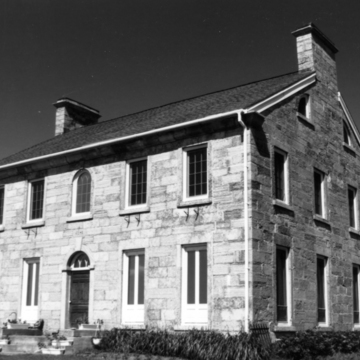Joseph Mott was an early settler of Alburg, purchasing over one thousand acres along the west shore of the peninsula. In 1825 his son, Joseph M. Mott, began a ferry from Alburg to the New York shore. That same year he commissioned this landmark, two-story, central-hall house constructed of dressed and coursed Isle La Motte limestone. It is uncertain whether the stone was cut and laid by James Ritchie, by Nathan Strong of Isle La Motte (who erected the Samuel Mott house nearby), or, most likely, by Mott, Strong, and Mott, who are credited with the county courthouse (GI6). Whoever was responsible, this stone house, with two end chimneys and arched doorway and second-floor central window (with “1825” carved above its keystone), marks the high point of early island masonry with a quality surpassing any then found elsewhere in the state. A number of stone houses in Alburg share similarly fine window surrounds and arched entrances. Within, one side of the first floor is a double parlor separated by a wide arch, and the kitchen was located in the basement. Joseph M. Mott's son George Henry Mott succeeded to his father's house and continued the ferry business through the end of the nineteenth century.
You are here
Mott House
If SAH Archipedia has been useful to you, please consider supporting it.
SAH Archipedia tells the story of the United States through its buildings, landscapes, and cities. This freely available resource empowers the public with authoritative knowledge that deepens their understanding and appreciation of the built environment. But the Society of Architectural Historians, which created SAH Archipedia with University of Virginia Press, needs your support to maintain the high-caliber research, writing, photography, cartography, editing, design, and programming that make SAH Archipedia a trusted online resource available to all who value the history of place, heritage tourism, and learning.















